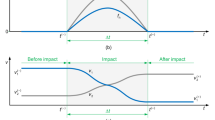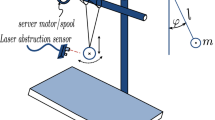Abstract
Based on the dynamical theory of multi-body systems with nonholonomic constraints and an algorithm for complementarity problems, a numerical method for the multi-body systems with two-dimensional Coulomb dry friction and nonholonomic constraints is presented. In particular, a wheeled multi-body system is considered. Here, the state transition of stick-slip between wheel and ground is transformed into a nonlinear complementarity problem (NCP). An iterative algorithm for solving the NCP is then presented using an event-driven method. Dynamical equations of the multi-body system with holonomic and nonholonomic constraints are given using Routh equations and a constraint stabilization method. Finally, an example is used to test the proposed numerical method. The results show some dynamical behaviors of the wheeled multi-body system and its constraint stabilization effects.
Similar content being viewed by others
References
Flores, P. and Ambrósio, J. On the contact detection for contact-impact analysis in multi-body systems. Multibody System Dynamics, 24, 103–122 (2010)
Flores, P., Leine, R., and Glocker, C. Application of the non-smooth dynamics approach to model and analysis of the contact-impact events in cam-follower systems. Nonlinear Dynamics, 69, 2117–2133 (2012)
Glocker, C. and Studer, C. Formulation and preparation for numerical evaluation of linear complementarity systems in dynamics. Multibody System Dynamics, 13, 447–163 (2005)
Forg, M., Pfeiffer, F., and Ulbrich, H. Simulation of unilateral constrained systems with many bodies. Multibody System Dynamics, 14, 137–154 (2005)
Leine, R. I. and van de Wouw, N. Stability properties of equilibrium sets of non-linear mechanical systems with dry friction and impact. Multibody System Dynamics, 51, 551–583 (2008)
Wang, Q., Tian, Q., and Hu, H. Dynamic simulation of frictional multi-zone contacts of thin beams. Nonlinear Dynamics, 83, 1–19 (2015)
Zhao, Z. and Liu, C. Contact constraints and dynamical equations in Lagrangian systems. Multibody System Dynamics, 38, 77–99 (2016)
Angelov, T. A. Variational analysis of thermomechanically coupled steady-state rolling problem. Applied Mathematics and Mechanics (English Edition), 34, 1361–1372 (2013) DOI 10.1007/s10483-013-1751-6
Schiehlen, W. Research trends in multi-body system dynamics. Multibody System Dynamics, 18, 3–13 (2007)
Pfeiffer, F. and Glocker, C. Multibody Dynamics with Unilateral Contacts, Wiley-VCH, New Jersey (2004)
Zhuang, F. and Wang, Q. Modeling and simulation of the non-smooth planar rigid multi-body systems with frictional translational joints. Multibody System Dynamics, 29, 403–423 (2013)
Chiu, C. H. Self-tuning output recurrent cerebellar model articulation controller for a wheeled inverted pendulum control. Neural Computing and Applications, 29, 1153–1164 (2010)
Horin, P. B., Djerassi, S., Shoham, M., and Horin, R. B. Dynamics of a six degrees-of-freedom parallel robot actuated by three two-wheel carts. Multibody System Dynamics, 16, 105–121 (2006)
Sankaranarayanan, V. and Mahindrakar, A. D. Switched control of a nonholonomic mobile robot. Communications in Nonlinear Science and Numerical Simulation, 14, 2319–2327 (2009)
Terze, Z. and Naudet, J. Structure of optimized generalized coordinates partitioned vectors for holonomic and non-holonomic systems. Multibody System Dynamics, 24, 1–16 (2010)
Tasora, A. and Anitescu, M. A complementarity-based rolling friction model for rigid contacts. Meccanica, 48, 1643–1659 (2013)
Saux, C. L., Leine, R. I., and Glocker, C. Dynamics of a rolling disk in the presence of dry friction. Journal of Nonlinear Science, 15, 27–61 (2005)
Marques, F., Flores, P., Claro, J. C. P., and Lankarani, H. M. A survey and comparison of several friction force models for dynamic analysis of multi-body mechanical systems. Nonlinear Dynamics, 86, 1407–1443 (2016)
Flores, P., Sio, J., Claro, J., and Lankarani, H. Influence of the contact-impact force model on the dynamic response of multi-body systems. Proceedings of the Institution of Mechanical Engineers, Part K: Journal of Multi-body Dynamics, 220, 21–34 (2006)
Bagci, C. Dynamic motion analysis of plane mechanisms with Coulomb and viscous damping via the joint force analysis. Journal of Engineering for Industry, 97, 551–560 (1975)
Rooney, G. T. and Deravi, P. Coulomb friction in mechanism sliding joints. Mechanism and Machine Theory, 17, 207–211 (1982)
Haug, E. J., Wu, S. C., and Yang, S. M. Dynamics of mechanical systems with Coulomb friction, stiction, impact and constraint addition-deletion I: theory. Mechanism and Machine Theory, 21, 401–406 (1986)
Pfeiffer, F., Foerg, M., and Ulbrich, H. Numerical aspects of non-smooth multi-body dynamics. Computer Methods in Applied Mechanics and Engineering, 195, 6891–6908 (2006)
Lemke, C. E. Some pivot schemes for the linear complementarity problem. Mathematical Programming Studies, 7, 15–35 (1978)
Eaves, B. C. The linear complementarity problem. Management Science, 17, 612–634 (1971)
Pfeiffer, F. On non-smooth dynamics. Meccanica, 42, 533–554 (2008)
Blajer, W. Methods for constraint violation suppression in the numerical simulation of constrained multi-body systems—–a comparative study. Computer Methods in Applied Mechanics and Engineering, 200, 1568–1576 (2011)
Wang, Q., Peng, H., and Zhuang, F. A constraint-stabilized method for multi-body dynamics with friction-affected translational joints based on HLCP. Discrete and Continuous Dynamical Systems Series B, 2, 589–605 (2011)
Flores, P., Machado, M., Seabra, E., and Silva, M. T. D. A parametric study on the Baumgarte stabilization method for forward dynamics of constrained multibody systems. Journal of Computational and Nonlinear Dynamics, 6, 73–82 (2009)
Neto, M. A. and Ambrósio, J. Stabilization methods for the integration of DAE in the presence of redundant constraints. Multibody System Dynamics, 10, 81–105 (2003)
Braun, D. J. and Goldfarb, M. Eliminating constraint drift in the numerical simulation of constrained dynamical systems. Computer Methods in Applied Mechanics and Engineering, 198, 3151–3160 (2009)
Marsden, J. E., Ratiu, T. S., and Scheurle, J. Reduction theory and the Lagrange-Routh equations. Journal of Mathematical Physics, 41, 3379–3429 (2000)
Isac, G. Complementarity problems. Journal of Computational and Applied Mathematics, 124, 303–318 (2000)
Harker, P. T. and Pang, J. S. Finite-dimensional variational inequality and nonlinear complementarity problems: a survey of theory, algorithms and applications. Mathematical Programming, 48, 161–220 (1990)
Leine, R. I., Campen, D. H. V., and Glocker, C. H. Nonlinear dynamics and modeling of various wooden toys with impact and friction. Journal of Vibration and Control, 9, 25–78 (2003)
Kwak, B. M. Complementarity problem formulation of three-dimensional frictional contact. Journal of Applied Mechanics, 58, 134–140 (1989)
Author information
Authors and Affiliations
Corresponding author
Additional information
Project supported by the National Natural Science Foundation of China (Nos. 11372018 and 11572018)
Rights and permissions
About this article
Cite this article
Xu, Z., Wang, Q. & Wang, Q. Numerical method for dynamics of multi-body systems with two-dimensional Coulomb dry friction and nonholonomic constraints. Appl. Math. Mech.-Engl. Ed. 38, 1733–1752 (2017). https://doi.org/10.1007/s10483-017-2285-8
Received:
Revised:
Published:
Issue Date:
DOI: https://doi.org/10.1007/s10483-017-2285-8
Keywords
- non-smooth dynamics
- nonholonomic constraint
- Coulomb dry friction
- two-dimensional friction
- nonlinear complementarity problem (NCP)




